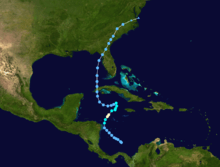Hurricane Alma (1970)
| Category 1 hurricane (SSHWS/NWS) | |
 Hurricane Alma on May 20 | |
| Formed | May 17, 1970 |
|---|---|
| Dissipated | May 26, 1970 |
| Highest winds |
1-minute sustained: 80 mph (130 km/h) |
| Lowest pressure | 993 mbar (hPa); 29.32 inHg |
| Fatalities | 8 total |
| Areas affected | Cayman Islands, Jamaica, Cuba, Southeast United States |
| Part of the 1970 Atlantic hurricane season | |
Hurricane Alma was one of only four Atlantic tropical cyclones to reach hurricane status in the month of May. It developed on May 17, 1970 north of Panama, and rapidly intensified on May 20 to peak winds of 80 mph (130 km/h), near Jamaica and the Cayman Islands. It stalled south of Cuba and deteriorated due to wind shear, and by May 22 it weakened to tropical depression status. After progressing northwestward and crossing western Cuba, Alma reorganized in the Gulf of Mexico, although continued shear prevented strengthening. It moved across Florida on May 25, and on May 27 it dissipated off the coast of Virginia.
The storm first brought gusty winds and heavy rainfall to Jamaica and the Cayman Islands. While it was weakening, Alma produced flooding in central and eastern Cuba, causing seven deaths and forcing 3,000 people to evacuate. Moderate precipitation spread across Florida, while thunderstorms from the storm caused light damage and killed one girl. Moisture from the storm spread up the Atlantic coast.
Meteorological history

Late on May 17, the US National Hurricane Center, reported that a tropical depression had formed about 470 miles (760 km) to the southeast of Kingston, Jamaica. Over the next couple of days, the depression became better organized as it moved towards the northwest; on May 19 it entered an area of favorable environmental conditions, which enabled the depression to rapidly intensify. On May 20 it strengthened into a tropical storm, at which point it was given the name Alma. That day, it rapidly strengthened under favorable developmental conditions, which included low wind shear, strong upper-level outflow, and apparent eastward inflow. Later on May 20, a Navy reconnaissance plane recorded winds of 80 mph (130 km/h), which proved to be the peak intensity of Alma.[1] It became one of only four Atlantic hurricanes on record in the month of May.[2]
Subsequent to its peak intensity, increasing westerly shear disrupted the storm's circulation and thermal pattern, which caused rapid weakening to tropical storm strength and later tropical depression status.[1] By May 22, the low pressure area became poorly defined after stalling south of Cuba; with only a few squalls and showers, advisories were discontinued on Alma.[3] The remnants of Alma continued westward near the Cayman Islands, and later turned to the north, passing over western Cuba.[4]
On May 24, the low pressure area reorganized as spiral rainbands became more evident on radar, and Alma was re-classified as a tropical depression.[5] As the depression approached the Florida coast, radar imagery indicated the system remained well-organized, with a spiral band structure around an eye feature; however, wind shear limited convection and strength, and Alma moved ashore as a depression near Cedar Key on May 25. It turned northeastward and moved across the southeastern United States, becoming extratropical in North Carolina on May 27. After moving off the coast of Virginia, the remnants of Alma were absorbed by an approaching cold front.[4]
Impact

After Alma weakened from hurricane status, it passed near the Cayman Islands on May 21, where winds of up to 65 mph (105 km/h) were recorded.[6] Gale force winds and heavy rainfall also occurred in Jamaica.[7] Heavy rains ahead of the storm caused flash flooding in central and eastern Cuba.[4] Seven people died as a result, and several homes were destroyed. The flooding forced the evacuation of 3,000 people in Oriente Province. Inclement weather closed 16 sugar mills, which stalled harvesting that was already behind schedule in the country.[8]
In Florida, the remnants of Alma brought rainfall across most of the state, with some isolated areas experiencing 5 inches (12.70 cm) or more. The highest rainfall from the storm was near Miami, Florida, with 6.66 inches (16.92 cm) of rain.[9] The rainfall was beneficial in alleviating drought conditions,[4] although thunderstorms caused hazardous driving conditions in the Florida Keys and elsewhere in the state.[10] Small craft warnings were posted along the coast.[11] One girl died from lightning in Miami,[12] and a thunderstorm near Fort Myers damaged some roofs and outbuildings.[13] In Saint Petersburg, flooding disrupted phonelines in about 400 households.[14] Merritt Island experienced 45 mph (72 km/h) wind gusts.[15] In Georgia, South Carolina, North Carolina, Virginia, and Maryland, Alma dropped moderate rainfall, with some isolated areas receiving up to 3 inches (7.62 cm).[9] Near Columbia, South Carolina, the remnants of Alma spawned a tornado which destroyed a roof.[14]
See also
- List of tropical cyclones
- List of Atlantic hurricanes
- 1970 Atlantic hurricane season
References
- ↑ 1.0 1.1 National Hurricane Center (1970). "Hurricane Alma Preliminary Report (Page 1)". Retrieved 2009-10-26.
- ↑ National Hurricane Center; Hurricane Research Division (March 2, 2015). "Atlantic hurricane best track (HURDAT version 2)". United States National Oceanic and Atmospheric Administration. Retrieved April 25, 2015.
- ↑ RHS/GBC (1970-05-22). "Tropical Depression Alma advisory". National Hurricane Center. Retrieved 2009-12-26.
- ↑ 4.0 4.1 4.2 4.3 National Hurricane Center (1970). "Hurricane Alma Preliminary Report (Page 2)". Retrieved 2009-10-26.
- ↑ Sugg (1970-05-24). "Tropical Depression Alma bulletin". National Hurricane Center. Retrieved 2009-12-26.
- ↑ National Hurricane Center (1970). "Observations from the Cayman Islands". Retrieved 2009-12-26.
- ↑ National Hurricane Center (1970). "Hurricane Alma Marie Advisory". Retrieved 2009-12-26.
- ↑ The Miami News (1970). "Seven Cubans Drown in Floods of Alma". Retrieved 2010-02-19.
- ↑ 9.0 9.1 National Hurricane Center (1970). "Hurricane Alma — Rainfall". Retrieved 2009-10-26.
- ↑ National Hurricane Center (1970). "Thunderstorms in the Florida Keys". Retrieved 2009-12-26.
- ↑ National Weather Service (1970). "Fort Myers Weather Statement". Retrieved 2009-12-26.
- ↑ National Hurricane Center (1970). "Deaths from Hurricane Alma". Retrieved 2009-12-26.
- ↑ National Hurricane Center (1970). "Wind Damage Reports from Alma". Retrieved 2009-12-26.
- ↑ 14.0 14.1 Saint Petersburg Times (1970). "Alma Brings an End to the Drought". Retrieved 2010-02-17.
- ↑ National Hurricane Center (1970). "Merritt Island Wind Reports". Retrieved 2009-12-26.
| ||||||||||||||||||||||||||||||
| ||||||||||||||||||||||||||||||||||||||||||||||||||||||||||||||||
